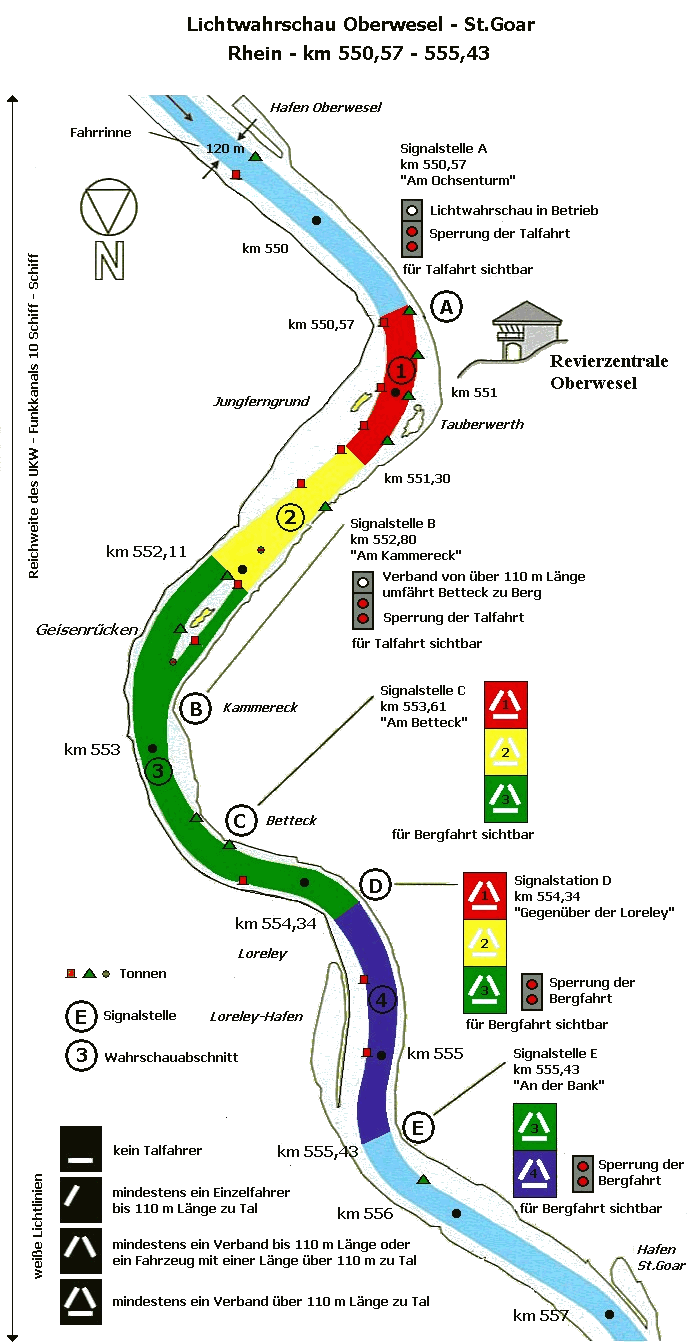Wahrschau (Una advertencia para los buques)
To this very day the Loreley passage is still very dangerous for shipping.
Because of the strongly wound and close curves the Loreley passage requires good knowledge of the locations, the flow conditions as well as experienced nautical proficiency.
Over the entire section between Oberwesel and St. Goar there is neither sufficient view nor a firsthand UKW radiotelephone communication from ship to ship.
A "Wahrschau" (from the Dutch waarschuwen = to warn) has been established to control the shipping traffic at these narrows.
Which signal is indicated with which ship you may test already, before we will explain in detail the Light-Wahrschau located in the valley of the Loreley.
62m to 150m
collective shipping?
Wahrschau (se�ales de advertencia) en la distancia la monta�a del r�o Rin

Situation
Because of the deeply cut, strongly wound and narrow Rhine Valley there is neither sufficient view nor a firsthand UKW radiotelephone communication (UKW channel 10) from ship to ship between Oberwesel and St. Goar over a distance of about 5 km. Depending upon the kind of ships involved a meeting in the curves must be avoided. Because of the strong current only the upstream traffic can wait. That needs to know whether any ships and which kind of ships come to meet in the valley.
Control
The approach of downstream traffic is signalled to the upstream traffic - with the exception of small boats - at the signal stations C, D and E. Each of these signal stations informs the upstream traffic on fields standing one above the other. Each field is assigned to a section of the route. The combination of the white light lines symbolizes the kind of the ship or collective (see legend on the sketch). Those Wahrschau are working around the clock all year round.
Supervision
The light signals are operated by the river headquarters in Oberwesel. The Wahrschau man observes the whole route on monitors. This is possible thanks to 4 land radar stations transferring pictures to the river headquarters. The Wahrschau man is reachable on the UKW channel 18.
UKW - radio installation
In order to enable radio traffic on UKW channel 10 also in the very winding section, there are radio communication systems ashore in Oberwesel and in St. Goar, which are connected by a cable. There the radiograms sent from the ships at one end of the section are received, led over the cable to the other end of the section and emitted there again. A deep tone of 1 second duration signals the normal mode of the radio communication system.
Source: With friendly support from the "Water and Shipping Authority Bingen".
|
The Light-Wahrschau in the mountain section of the Rin
- special warning signals - from Petra Schneider WSA Bingen PDF - Document - only in German |
|
|||||
| Source: Foto Loreleyfelsen Felix König | © 2006 - 2014 go_on Software GmbH |
||||










